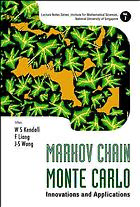Table Of ContentMARHOV CHAIN
MONTE CARLO
Innovations and Applications
LECTURE NOTES SERIES
Institute for Mathematical Sciences, National University of Singapore
Series Editors: Louis H. Y. Chen and Denny Leung
Institute for Mathematical Sciences
National University of Singapore
Published
Vol. 1 Coding Theory and Cryptology
edited by Harald Niederreiter
Vol. 2 Representations of Real and p-Adic Groups
edited by Eng-Chye Tan & Chen-Bo Zhu
Vol. 3 Selected Topics in Post-Genome Knowledge Discovery
edited by Limsoon Wong & Louxin Zhang
Vol. 4 An Introduction to Stein’s Method
edited by A. D. Barbour & Louis H. Y. Chen
Vol. 5 Stein's Method and Applications
edited by A. D. Barbour & Louis H. Y. Chen
Vol. 6 Computational Methods in Large Scale Simulation
edited by K.-Y. Lam & H.-P. Lee
Vol. 7 Markov Chain Monte Carlo: Innovations and Applications
edited by W. S. Kendall, F. Liang & J.-S. Wang
Lecture Notes Series, Institute for Mathematical Sciences,
National Unveersity of Sigapore
MARKOV CHAIN
mONTE CARLO
Innovations and Applications
Editors
w s Kendall
Univeersity of Warwick, UK
F Liang
Texas A & M University, Usa
J-S Wang
National Unversity of Ssingapore, Singaproe
World Scienctific
NEW JERSEY LONDON SINGAPORE BEIJING SHANGHAI HONG KONG TAIPEI CHENNAI
Published by
World Scientific Publishing Co. Pte. Ltd.
5 Toh Tuck Link, Singapore 596224
USA office: 27 Warren Street, Suite 401-402, Hackensack, NJ 07601
UK office: 57 Shelton Street, Covent Garden, London WC2H 9HE
British Library Cataloguing-in-Publication Data
A catalogue record for this book is available from the British Library.
MARKOV CHAIN MONTE CARLO
Innovations and Applications
Copyright © 2005 by World Scientific Publishing Co. Pte. Ltd.
All rights reserved. This book, or parts thereof, may not be reproduced in any form or by any means,
electronic or mechanical, including photocopying, recording or any information storage and retrieval
system now known or to be invented, without written permission from the Publisher.
For photocopying of material in this volume, please pay a copying fee through the Copyright
Clearance Center, Inc., 222 Rosewood Drive, Danvers, MA 01923, USA. In this case permission to
photocopy is not required from the publisher.
ISBN 981-256-427-6
Printed in Singapore.
CONTENTS
Foreword vii
Preface ix
Glossary xiii
Introduction to Markov Chain Monte Carlo Simulations and
Their Statistical Analysis
B. A. Berg 1
An Introduction to Monte Carlo Methods in Statistical Physics
D. P. Landau 53
Notes on Perfect Simulation
W. S. Kendall 93
Sequential Monte Carlo Methods and Their Applications
R. Chen 147
MCMC in the Analysis of Genetic Data on Pedigrees
E. A. Thompson 183
Index 217
v
TThhiiss ppaaggee iinntteennttiioonnaallllyy lleefftt bbllaannkk
FOREWORD
The Institute for Mathematical Sciences at the National University of Sin-
gapore was established on 1 July 2000 with funding from the Ministry of
Education and the University. Its mission is to provide an international
center of excellence in mathematical research and, in particular, to pro-
mote within Singapore and the region active research in the mathematical
sciences and their applications. It seeks to serve as a focal point for scien-
tistsofdiversebackgroundstointeractandcollaborateinresearchthrough
tutorials, workshops,seminars and informal discussions.
TheInstituteorganizesthematicprogramsofdurationrangingfromone
to six months.The theme or themes of eachprogramwill be in accordance
withthe developingtrends ofthemathematicalsciences andthe needsand
interestsofthelocalscientificcommunity.Generally,foreachprogramthere
will be tutorial lectures on background material followed by workshops at
the researchlevel.
As the tutorial lectures form a core component of a program, the lec-
turenotesareusuallymadeavailabletotheparticipantsfortheirimmediate
benefit during the period of the tutorial. The main objective of the Insti-
tute’s Lecture Notes Series is to bring these lectures to a wider audience.
Occasionally,theSeriesmayalsoincludetheproceedingsofworkshopsand
expository lectures organized by the Institute. The World Scientific Pub-
lishing Company and the Singapore University Press have kindly agreed
to publish jointly the Lecture Notes Series. This volume, “Markov Chain
Monte Carlo: Innovations and Applications” is the seventh of this Series.
WehopethatthroughregularpublicationoflecturenotestheInstitutewill
achieve, in part, its objective of promoting research in the mathematical
sciences and their applications.
July 2005 Louis H. Y. Chen
Denny Leung
Series Editors
vii
TThhiiss ppaaggee iinntteennttiioonnaallllyy lleefftt bbllaannkk
PREFACE
ThetechniqueofMarkovchainMonteCarlo(MCMC)firstaroseinstatisti-
calphysics,markedbythecelebrated1953paperofMetropolis,Rosenbluth,
Rosenbluth, Teller and Teller. The underlying principle is simple: if one
wishes to sample randomly from a specific probability distribution then
design a Markov chain whose long-time equilibrium is that distribution,
write a computer programto simulate the Markov chain, and run the pro-
grammed chain for a time long enough to be confident that approximate
equilibrium has been attained; finally recordthe state of the Markovchain
asanapproximatedrawfromequilibrium.TheMetropoliset al.paperused
a symmetric Markov chain; later developments included adaptation to the
case of non-symmetric Markov chains.
Thetechnique has developedstrongly in the statisticalphysics commu-
nity but also in separate ways and with rather different emphases in the
computer science community concerned with the study of random algo-
rithms (where the emphasis is on whether the resulting algorithm scales
well with increasing size of the problem), in the spatial statistics commu-
nity (where oneis interested in understanding what kinds ofpatterns arise
fromcomplexstochasticmodels),andalsointheappliedstatisticscommu-
nity (where it is applied largely in Bayesian contexts, enabling researchers
to formulate statistical models which would otherwise be intransigent to
effective statistical analyses).
Within the statistical physics community, the MCMC technique lies
at the heart of the tradition of “simulation physics”: understanding phase
transition and other physical behaviour by constructing careful simulation
experimentsonthecomputer.Aparticularlineofdevelopmentforthepast
10 years in the statistical physics community is that of extended ensemble
methods, beginning with Berg’s work on the multicanonical method, fol-
lowed by simulated tempering, parallel tempering, broadhistogramMonte
Carlo, transition matrix Monte Carlo, etc. These methods substantially
ix

